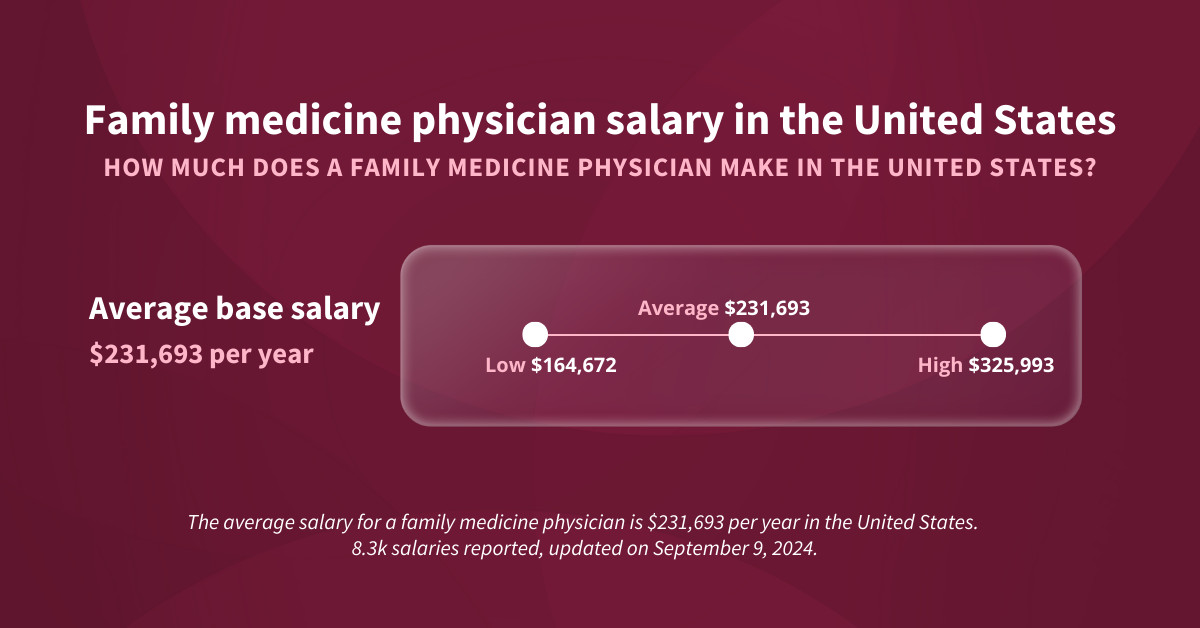Delve into the world of Family Medicine Fellowships and discover how they can elevate your career.
Updated February 19, 2025Published September 14, 2021
Many are drawn to the field of family medicine for its expansive nature, unbound by specific ailments, organs, or patient demographics. Family medicine offers the unique privilege of caring for diverse families and individuals across all ages, genders, and health journeys. A family medicine specialist is defined by their commitment to delivering holistic healthcare to everyone from infants to the elderly. Embracing this broad spectrum of care and dedicating oneself to diverse patient needs are hallmarks of becoming a family medicine doctor.
However, for physicians seeking to refine their expertise and deepen their knowledge, family medicine fellowships present exciting avenues for specialization. These fellowships are ideal for family medicine practitioners who find themselves particularly drawn to specific facets within this dynamic field. Continue reading to explore the subspecialties available in family medicine and learn how fellowships can pave your way to becoming a highly specialized family medicine physician.
Understanding the Role of a Family Medicine Physician
Let’s first clarify, ‘What does a family doctor actually do?’ Family medicine stands out as one of the most encompassing medical specialties. Physicians in this field are equipped to treat a vast range of patients, spanning all genders and age groups. Family medicine is a cornerstone of primary healthcare, with the American Academy of Family Physicians (AAFP) characterizing family doctors as professionals ‘dedicated to treating the whole person.’ This holistic approach means family medicine physicians are trained to understand the intricate workings of the entire body, rather than concentrating solely on a single organ or disease.
Beyond treating illnesses, a family medicine physician plays a vital role in preventative care. They conduct routine check-ups, including comprehensive health screenings, risk assessments, and provide crucial counseling on healthy lifestyle choices and their implementation.
Diving into Family Medicine Subspecialties and Fellowships
Family medicine doctors champion integrated patient care, treating individuals holistically. Their extensive training prepares them to deliver comprehensive healthcare and manage a wide array of conditions. Yet, within this broad specialty, opportunities abound to specialize in a particular area of family medicine through fellowship training. This allows physicians to develop focused expertise while maintaining a strong foundation in overall healthcare. A diverse range of family medicine subspecialties is available for physicians seeking advanced training. Let’s explore these specialized paths:
Adolescent Medicine Fellowships
A family physician specializing in adolescent medicine becomes a multidisciplinary healthcare expert. Through specialized fellowship, they gain in-depth knowledge of the unique physical, psychological, and social characteristics of adolescents, enabling them to effectively address the healthcare challenges specific to this age group.
Geriatric Medicine Fellowships
Geriatric medicine fellowships equip family physicians with specialized knowledge of the aging process. These specialists are dedicated to caring for elderly patients in various settings, including homes, offices, long-term care facilities, and hospitals. Their advanced skills enable them to excel in the diagnostic, therapeutic, preventive, and rehabilitative aspects of illnesses affecting older adults.
Hospice and Palliative Medicine Fellowships
Specialists in hospice and palliative medicine, after completing a dedicated fellowship, are family physicians focused on alleviating and preventing suffering in patients with life-limiting illnesses. They collaborate closely with interdisciplinary hospice or palliative care teams to enhance their patients’ quality of life. Their training encompasses addressing the physical, psychological, social, and spiritual needs of both patients and their families.
Pain Medicine Fellowships
Pain medicine fellowships train family physicians to diagnose and treat patients experiencing acute or chronic pain, both in hospital and outpatient environments. They are also adept at managing cancer-related pain. These specialists often collaborate with other medical professionals to ensure coordinated and comprehensive patient care.
Sleep Medicine Fellowships
Family physicians specializing in sleep medicine through fellowship programs become experts in diagnosing and managing clinical conditions that occur during sleep. This includes disorders that disrupt sleep or are influenced by disturbances in the sleep-wake cycle. Sleep medicine specialists are proficient in analyzing polysomnography and possess expertise in managing sleep laboratories.
Sports Medicine Fellowships
A sports medicine specialist who has completed a fellowship in sports medicine is a family physician uniquely qualified to prevent, diagnose, and treat injuries related to sports and exercise. This family medicine subspecialty also addresses illnesses and conditions that can impact physical health and athletic performance.
 A list of family medicine subspecialties
A list of family medicine subspecialties
Alt text: Diverse Family Medicine Subspecialties including Adolescent Medicine, Geriatric Medicine, Hospice and Palliative Medicine, Pain Medicine, Sleep Medicine, and Sports Medicine.
Choosing the Right Family Medicine Fellowship
Selecting a family medicine subspecialty and, consequently, a fellowship, requires careful consideration of several factors. The most crucial element is aligning your choice with your genuine interests and passions within family medicine. Your enthusiasm should extend to both the clinical practice within the subspecialty and the potential for research and advancement in that field. Medical students should actively seek experiences in subspecialties that pique their interest through clinical electives during rotations. This firsthand exposure is invaluable in determining both enjoyment and suitability for a particular subspecialty.
During these elective rotations, critical self-reflection is essential. Ask yourself: ‘Can I envision myself happily practicing this for my entire career?’ Seek guidance from experienced mentors within your desired subspecialties. Engage in discussions about the opportunities and challenges they encounter, and their perspectives on the future evolution of the field over the next decade and beyond. Connect with current fellows to gain insights into their experiences and the factors that guided their subspecialty choices. These conversations can provide invaluable real-world perspectives on family medicine fellowships.
The Fellowship Journey in Family Medicine
Family medicine physicians who decide to specialize pursue fellowship training after completing their residency. In family medicine, a fellowship involves a period of intensive training where a physician, known as a fellow, works closely with specialists to gain expertise in a chosen subspecialty, such as those detailed above.
Specialization is a highly sought-after path in medicine, making it a competitive arena. The physicians who lead family medicine fellowship training programs are recognized experts and leaders in their respective fields. This provides fellows with an unparalleled learning experience, working side-by-side with the best.
Upon completing a family medicine subspecialty fellowship and becoming a specialist, physicians can further validate their expertise by earning a subspecialization certificate. This involves additional training and examinations. Uniquely, family medicine requires physicians to maintain certification in both family medicine and their chosen subspecialty. Certificates of Added Qualification (CAQs) are valid for ten years, and renewal requires applying for recertification, in addition to the decennial recertification in family medicine itself. This commitment to continuous learning and certification underscores the dedication to excellence within family medicine subspecialties and fellowship training.
Weighing the Decision: Is a Family Medicine Subspecialty Right for You?
Choosing a subspecialty in family medicine involves considering both advantages and disadvantages. Generally, fellowships extend for at least 12 months beyond residency, though program durations can vary. This additional training naturally lengthens your overall education timeline. Furthermore, focusing on a subspecialty may mean forgoing some of the breadth of experience gained during family medicine residency. Residency provides comprehensive training across the entire human lifespan, from infancy to old age. This broad knowledge base may become somewhat less emphasized as a physician concentrates on a single specialty.
Consider also your vision for career versatility and flexibility. Family physicians are multi-faceted specialists who deliver care across diverse settings, from private practices and hospitals to inpatient facilities and community health centers. They are responsive to community and patient needs, adapting their procedures and tailoring clinical services accordingly. Specialists, by nature of their focused expertise, may experience less of this flexibility as their specialty largely defines their patient population and practice settings.
However, if your aspiration is to become a leading expert in a specific area, driving innovation and conducting research within a subspecialty you are deeply passionate about, then pursuing a family medicine subspecialty through a fellowship is an excellent path. Family medicine fellowships offer an exceptional experience, providing the opportunity to learn from the foremost experts in a field and refine your focus on an area that genuinely inspires you.
Ultimately, the decision hinges on a fundamental question: ‘What do I want to dedicate my career to?’ Let your passions and clinical interests guide your choices, and you will undoubtedly chart a fulfilling and impactful medical career path through family medicine and its specialized fellowships.
Family Medicine Career Paths and Compensation
 Alt text: Family Medicine Physician Salary in the United States ranging from $200,000 to $250,000 USD per year.
Alt text: Family Medicine Physician Salary in the United States ranging from $200,000 to $250,000 USD per year.
For the most current financial information, please visit: www.indeed.com/career/family-medicine-physician/salaries
Family medicine physicians are essential to the healthcare system, providing comprehensive care throughout all stages of life. Their ability to practice in varied environments – from hospitals and clinics to private practices – ensures a dynamic and rewarding career. For those considering family medicine fellowships, it’s important to understand the career landscape.
In the United States, family medicine physician salaries typically range from $200,000 to $250,000 USD annually. This can fluctuate based on factors like experience, geographic location, and practice setting. According to the AAFP, physicians in high-demand areas or with greater experience can earn upwards of $300,000 USD per year. While subspecialist salaries can vary considerably, increased specialization and experience generally correlate with higher compensation. Importantly, family medicine offers a satisfying balance between patient care and work-life integration, making it an appealing choice for those who value long-term patient relationships and community health. Family medicine fellowships can further enhance career prospects and earning potential within this fulfilling field.
Choosing family medicine is embracing a profession dedicated to the well-being of individuals and families, offering significant opportunities for both personal and professional growth. As healthcare continues to evolve, the demand for skilled family medicine practitioners remains strong, ensuring a stable and impactful career trajectory, particularly with the added expertise gained through fellowship training.
Conclusion: Charting Your Course with Family Medicine Fellowships
For those considering medical school, decisions about family medicine fellowships and subspecialization may seem distant. However, it’s crucial to consider whether a program aligns with your long-term practice goals. Understanding the pathways available through family medicine fellowships is a vital part of career planning.
Through our accreditation status and key state approvals, Medical University of the Americas is committed to helping students achieve strong residency placement rates and establish practices across all 50 U.S. states, Canada, and globally. This foundation paves the way for pursuing quality fellowships and subspecialization opportunities in family medicine.
FAQs About Family Medicine
A general family medicine doctor provides comprehensive care for individuals of all ages, addressing a broad spectrum of illnesses and health needs. They often serve as a patient’s initial point of contact for any health concern. A family practice doctor specializing through fellowship in a specific branch of family medicine focuses on particular patient groups (e.g., adolescents, elderly) or medical areas (e.g., sports medicine, palliative medicine).
Family medicine doctors in the United States typically earn between $200,000 and $250,000 USD annually. Subspecialists and more experienced practitioners can achieve higher earnings. For the most current salary data, visit: indeed.com/career/family-medicine-physician/salaries
Aspiring family medicine doctors should prioritize an MD program that offers clinical rotations at reputable hospitals and medical centers. During rotations, students should explore electives in family medicine and related subspecialties to assess their fit for the field. Subsequently, they should apply for family medicine residencies and consider family medicine subspecialty fellowships post-residency.
Yes, family medicine is a broad medical specialty with numerous subspecialties available for further training. MD graduates interested in family medicine pursue a family medicine residency (typically 3 years) and can then subspecialize through post-residency fellowships in areas like sports medicine, pain medicine, geriatric medicine, and more. Family medicine fellowships are a key step in specialization.
 Alt text: Medical University of the Americas banner ad.
Alt text: Medical University of the Americas banner ad.
Useful links
pROGRAMS how to apply tuition Register for events
Get in touch for more information

